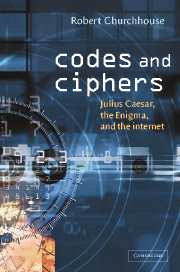Book contents
- Frontmatter
- Contents
- Preface
- 1 Introduction
- 2 From Julius Caesar to simple substitution
- 3 Polyalphabetic systems
- 4 Jigsaw ciphers
- 5 Two-letter ciphers
- 6 Codes
- 7 Ciphers for spies
- 8 Producing random numbers and letters
- 9 The Enigma cipher machine
- 10 The Hagelin cipher machine
- 11 Beyond the Enigma
- 12 Public key cryptography
- 13 Encipherment and the internet
- Appendix
- Solutions to problems
- References
- Name index
- Subject index
12 - Public key cryptography
Published online by Cambridge University Press: 13 August 2009
- Frontmatter
- Contents
- Preface
- 1 Introduction
- 2 From Julius Caesar to simple substitution
- 3 Polyalphabetic systems
- 4 Jigsaw ciphers
- 5 Two-letter ciphers
- 6 Codes
- 7 Ciphers for spies
- 8 Producing random numbers and letters
- 9 The Enigma cipher machine
- 10 The Hagelin cipher machine
- 11 Beyond the Enigma
- 12 Public key cryptography
- 13 Encipherment and the internet
- Appendix
- Solutions to problems
- References
- Name index
- Subject index
Summary
Historical background
The first general purpose computers were built in the 1940s. They were large, filling big rooms. They used hundreds of valves and consumed many kilowatts of electricity. They performed about a thousand instructions a second, which was considered amazing at that time, and they were popularly referred to as ‘giant brains’. A few people, including Alan Turing, discussed ‘whether machines could think’ and laid bets as to whether a machine would defeat the World Chess Champion in the next 25 years. The former question remains a matter for debate; the latter was settled about 45 years later when a World Chess Champion did lose a match to a computer.
These early machines had very small direct access memories, only a thousand or so ‘words’, based upon cathode ray tubes or mercury delay lines. They rarely functioned for more than a few minutes before breaking down. Their input and output were primitive: paper tape or punched cards and a typewriter. They also cost a great deal of money; £100 000 in 1948 which was equivalent to several millions 30 years later. Very few people knew how to write programs for them. There was virtually no software (as it later became known) and all programs had to be written in ‘absolute machine code’.
Even the instruction codes of these machines were very limited. The first machine at Manchester University in 1948, for example, had no division instruction [12.2], so division had to be programmed by repeated subtraction.
- Type
- Chapter
- Information
- Codes and CiphersJulius Caesar, the Enigma, and the Internet, pp. 161 - 169Publisher: Cambridge University PressPrint publication year: 2001



